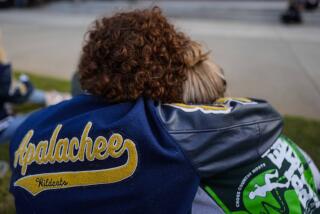Killers but a Drop in Internet’s Vast Ocean of Angst
- Share via
Before gunning down 13 people at Columbine High School near Denver on Tuesday, the two teenage killers left disturbing electronic footprints across the Internet.
There were drawings of horned beasts and figures brandishing knives. There were ominous quotes--”I kill who I don’t like”--and obscure references to “420,” the date of the shootings and Adolf Hitler’s birthday. There was even a recipe for pipe bombs.
But amid the oceans of angst unleashed every day on the Internet, the digital traces apparently left by these troubled Colorado teens amount to a few specks of sand.
Postings more malevolent than any attributed to these two are plentiful on the Net, where people tend to reveal their darkest thoughts from behind anonymous identities. Pipe bomb recipes abound, with instructions in far greater detail than the one apparently posted by gunman Eric Harris.
Experts said there was no way to anticipate Tuesday’s events from online warnings.
In fact, officials from the Simon Wiesenthal Center in Los Angeles said they had come across material from Harris and his fellow assailant, Dylan Klebold, during the organization’s recent sweep of hate content on the Internet. But the center dismissed it as exactly what it was until Tuesday: the all-too-common online posturing of disaffected teens.
“The full range of human expression is something you can find on the Internet,” said Mike Godwin, staff counsel for the Electronic Frontier Foundation, a civil liberties group. “And teenage alienation is pretty common.”
Many Internet experts cringed Wednesday at the inevitable effort to connect Tuesday’s horror to online behavior. Most believe that the Internet’s role in tragedies tends to be exaggerated, pointing to the flurry of stories several years ago about the Web site affiliated with the Heaven’s Gate cult that committed mass suicide in Rancho Santa Fe, Calif.
Nevertheless, authorities and Internet service providers on Wednesday were trying to preserve and piece together the scraps of electronic evidence related to the shootings.
America Online, for instance, removed a collection of files apparently created by Harris. There is also a great deal of information on the killers that is difficult to trace or verify. For instance, the purported America Online user profiles of the teens were being widely distributed in online news groups Wednesday.
Klebold’s supposed profile, under the user name WurmHole, lists his hometown as Littleton, Colo., his hobbies as “computers, chasing the ladies” and his personal quote as “420,” possibly a reference to Hitler’s April 20 birth date or an eerie precursor of Tuesday’s tragedy.
Harris may have had an account with WBS.net, an online community site, although company officials declined to comment on any content affiliated with specific members. His profile there says: “I kill who I don’t like, I waste what I don’t want, I destroy what I hate.”
Rabbi Abraham Cooper, who coordinates the ongoing digital hate study at the Wiesenthal Center, said researchers came across material from Harris and Klebold a month ago, but they didn’t think it merited inclusion in the center’s recently published list of 1,400 online hate sites. Still, Cooper said the teens probably learned about pipe bombs and military tactics online, “unless these kids had a guest terrorist giving them lectures.”
*
Times staff writers David Colker and Nona Yates contributed to this story.
More to Read
Sign up for Essential California
The most important California stories and recommendations in your inbox every morning.
You may occasionally receive promotional content from the Los Angeles Times.












